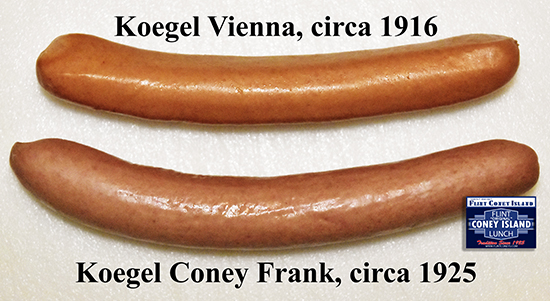
One of the most common misconceptions is described by Managing Culinary Director J. Kenji López-Alt over on the Serious Eats web site on January 6, 2012, in their “Taste Test: Natural Casing Hot Dogs From Michigan“:
This used to be true but it’s been quite a long time since this information was current. A law went into effect in Michigan in 1952 which, according to 1972 Michigan Department of Agriculture Director B. Dale Ball, “permits only the use of inspected skeletal meat in these products. It requires a minimum of 12 percent protein … Federal law permits the use of such animal by-products as hearts, lungs, tongues, tripe, eyes, udders, lips, ears, snouts, esophagi, glands, bladders and paunches … The federal law has no minimum protein requirement.”
- Those made only from skeletal meat, which can contain 15 percent poultry meat, and the normal ingredients – such as water, sweeteners and curing substances – needed for processing. These products will be labeled with their traditional generic names, such as “frankfurters”, “bologna” or “Knockwurst”. If all the meat is from one particular species, the product will have to be labeled to show that – such as “beef frankfurter”.
- Those made of the above ingredients plus meat byproducts – sometimes called variety meats – such as hearts, tongue, tripe, etc., and poultry meats. This type of product will have to be distinctly labeled as, for example, “frankfurters with byproducts” or “franks with variety meats”. The term “with byproducts” or “with variety meats” will have to be printed so that it can be easily noticed – by being next to and in the same color and background as the generic name. The ingredient statement must specifically name each byprduct, as it is now required.
- Those made with either of the above formulas, plus up to 3.5 percent nonmeat binders, such as nonfat dry milk, cereal or dried whole milk, or 2 percent isolated soy protein. These products also will have to be clearly labeled – with names such as “franks with byproducts, nonfat dry milk added”. And their extra ingredients will have to be named in the ingredient statement on the label.
=====
289.7131 Federally inspected meats; preemption of state ingredient standards. Sec. 7131. A person shall not sell or offer for sale a product that is not manufactured to the ingredient standards of this act unless the federal government legally preempts Michigan’s ingredient standards. In that case, federally inspected meats not meeting the ingredient requirements of this act shall be identified as federally inspected on intact, sealed packaging from the federally inspected location.
=====
289.7133 Artificial casings or containers; products considered as adulterated. Sec. 7133. (1) All products manufactured under terms of this chapter may be sold in colored artificial casings orcontainers only if the products are in complete compliance with all applicable regulations of the United States department of agriculture. These products shall not be sold in colored natural casings. (2) In addition to the requirements of section 1105(1)(a), any product manufactured under the terms of this chapter is adulterated if it is the product of an animal which has died otherwise than by slaughter.

I have had hot dogs in California that had a greenish tinge to them…quit eating bologna altogether cause it was horrible. And ask about pickled bologna and they have no idea!! Thank you Koegles and Dearborn!